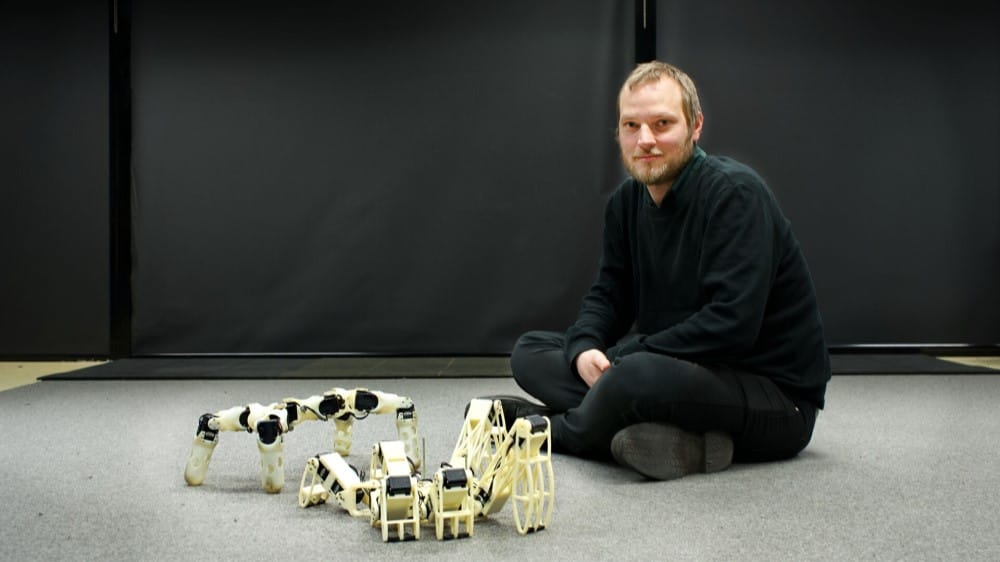
In the near future, a small robot can help clean water. In front of the unit stands a model of a sea creature: a coral polyp, whose tentacles form the corals in the ocean. This mechanical “wireless water polyp” can remove pollutant particles from the water – and collect and transport cells for analysis in diagnostic systems.
“I was inspired by the movements of these coral polyps. Especially their ability to deal with the environment using self-generated currents,” says Marina Pilz Da Cunha, a Ph.D. student at Eindhoven University of Technology. The function of the artificial polyp is comparable to that of the live model. The stem of the living polyps cause a specific movement that generates a current that attracts food particles. The tentacles then grab the food particles as they swim by.
The wirelessly controlled artificial polyp measures one square centimeter and has a stem that responds to magnetism, and tentacles that are guided by light. “The combination of these two stimuli is not often accomplished, because it requires very delicate manufacture and assembly processes. But it is very interesting when it comes to making robots because it makes complex movements and tasks feasible,” Pilz Da Cunha explains. The tentacles are moved by shining light on them. Various wavelengths each give a different result. For example, the tentacles ‘grab’ under the influence of UV light, while they ‘let go’ under blue light.
From land to water
This robot is a new version of the light-powered mini-package delivery robot presented earlier this year. This land robot turned out not to work underwater because the polymers that the robot is made of work with photothermal signals. It was the heat generated by the light, instead of the light itself, that fueled the robot. Pilz Da Cunha: “Heat quickly dissipates in water. Which meant it wasn’t possible to control the robot underwater.” So then she developed a photomechanical material, a material that only moves under the influence of light. Without the need for heat.
This is not the only advantage of the new material. Besides being able to work underwater, the material can also retain its shape after light stimulation. Whereas the photothermal material immediately regains its original shape after removal of the stimulus, the molecules in the photomechanical material assume a new form. This makes several stable forms possible, which last for a longer period of time. “This helps in controlling the gripping arm. Once something has been captured, the robot can hold on to its spoils until you release it,” Pilz Da Cunha adds.
Current attracts particles
The stem circles around its axis, as it were, by placing a rotating magnet underneath the robot (see video). Pilz Da Cunha: “This made it possible to actually move the floating objects in the water towards the polyp, oil drops, in our case.”
The position of the tentacles (open, closed, or something in between), turned out to have an influence on the current. “Computer simulations with various tentacle positions eventually helped us to understand the movement of the stem and consequently get it exactly right. And to ‘lure’ the oil droplets towards the tentacles,” Pilz Da Cunha goes on to explain.
In this video, the artificial polyp lures in the oil drop and grabs it. The stem moves by means of magnetism, creating a current in the water. This current pulls the oil droplets towards the tentacles. The tentacles then close up around the oil drop, when exposed to UV light. Blue light opens the tentacles again to release the droplet.Independent of the composition of water
The beauty of it is that the robot operates independently of the composition of the surrounding fluid. This is unique, because most of the stimulus-responsive materials used in underwater applications, namely hydrogels, are sensitive to their environment. This is why hydrogels behave differently in polluted water. Pilz Da Cunha: “Our robot works exactly the same way whether in saltwater or in water that is polluted. What’s more, the polyp may be able to filter contaminants out of the water in the future by capturing these using its tentacles.”
Next step: a swimming robot
Doctoral student Pilz Da Cunha is now working on the next step: a series of polyps that can work together. In doing this, she hopes to be able to make transportation of particles possible, whereby one polyp passes on a ‘package’ to the next. A robot that can swim is also on her wish list. Applications for this range from biomedical transport to the harvesting of specific cells.

In order to be able to achievere this, the researchers still have to work on the wavelengths that the material reacts to. “UV light affects cells, and the depth of penetration into the human body is limited. In addition, UV light may damage the robot, shortening its lifespan. That is why we are going to work on a robot that does not need UV light as a stimulus,” Pilz Da Cunha concludes.
The research was published on July 13 in the journal PNAS. It was carried out at the Faculty of Chemical Engineering and Chemistry and the Institute for Complex Molecular Systems at Eindhoven University of Technology. Title: An Artificial Aquatic Polyp that Wirelessly Attracts, Grasps and Releases Objects. DOI: https://doi.org/10.1073/pnas.2004748117







